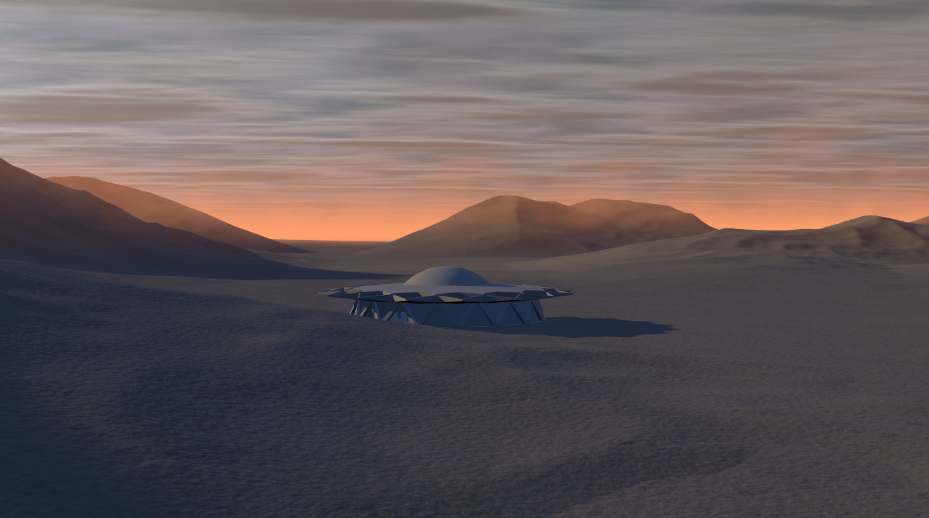
Flying Saucer, 2020
Lindsay Seers and Keith Sargent
Flying Saucer, 2020
From ‘Nowhere Less Now’,(2012–ongoing)
Digital image
Courtesy of the artist
Photo: Lindsay Seers and Keith Sargent
search


Lindsay Seers and Keith Sargent
Flying Saucer, 2020
From ‘Nowhere Less Now’,(2012–ongoing)
Digital image
Courtesy of the artist
Photo: Lindsay Seers and Keith Sargent
Nowhere Less Now is an episodic work that addresses the dark legacy of British colonialism and Lindsay Seers’ journey through history in search of (the) truth. Presented in cycles, it is conceptually structured around Henri Bergson's philosophy of memory. Seers builds on Bergson's complex proposition of 'intuition as practice' to develop a specific method for the act of filming. Formed from his three fundamental propositions for asking the right creative question, Seers’ method is based on reenactment and evocations that are created to reveal qualitative relationships between things. These connections, which may be conceptual, historical or visual, emerge as she travels to various locations. The resulting installation has a multitude of narrative streams and a collage of imagery as time (past, present, future) is compacted.
The Sharjah iteration of this work, Nowhere Less Now³ [flying saucer], significantly differs from the previous episodes in that it is embedded in a building of Googie architecture. Built next to a British military encampment in the mid-1970s and acquired by Sharjah Art Foundation in 2012 (it became an official venue in 2015), the futuristic structure is known as The Flying Saucer because of its shape. Basing her work on the Gulf Weekly Mirror’s 1978 report about the sighting of a flying saucer hovering over Dubai, Seers uses the unique architectural elements of the building to narrate an alien tourist’s landing and its fascination with the forces impelling humans to move to a pulse, a rhythm.
Seers frequently uses personal biography in order to reveal individual lives against the backdrop of grand historic narratives. The multimedia installation includes a film in which the principle narrator whose biography we follow is a dancer. Concerned with dance and its role in human societies, the imagery is underpinned by two protagonists, the Princess of Zanzibar (Emily Ruete) and a dance by Leni Riefenstahl for the film Holy Mountain (1924). From these interlaced points in time the social and cultural implications of dancing, fascism, colonialism spread out into images collected and viewed by an alien who tries to make sense of human imperatives
The installation, set significantly in the star-shaped building, delves deeper than these biographical stories into the nature of matter. Science and the encoded image stand at the crossroads of the work. The building itself stood on the boundary of territories between aliens (the British military) and the indigenous people. Layers of narratives shift into other dimensions that probe the nature of matter itself, inspired by the progressive scientific knowledge of the people of the region.
The alien attempts to understand something about life on Earth from geometry, gestures and movements. All the while, we are left to question whether we can find a way to move beyond language to nuanced deep thought that transcends cultural and biological stereotyping and reorders time as nonlinear—the present is immanent and not defined by the past and the future.
Nowhere Less Now was originally presented in 2012 at the Tin Tabernacle in Kilburn, London, by Artangel, an acclaimed UK non-profit arts organisation known for its adventurous artist commissions that have been realised in unusual sites and locations across the UK and around the world. The work’s second iteration, Nowhere Less Now 2, was presented in 2014 at the Museum of Old and New Art (MONA) as part of a group exhibition titled The Red Queen. Nowhere Less Now has been commissioned and produced by Artangel, London; Sharjah Art Foundation and the Museum of Old and New Art (MONA), Hobart, Tasmania.
![Lindsay Seers and Keith Sargent: Nowhere Less Now³ [flying saucer] Lindsay Seers and Keith Sargent: Nowhere Less Now³ [flying saucer]](/css/img/placeholder.gif)
Lindsay Seers’ artistic practice goes beyond simple storytelling to become a network in which conceptual investigation, a desire for photography to act as evidence, historical and personal contexts, and the camera itself merge.
![Lindsay Seers and Keith Sargent: Nowhere Less Now³ [flying saucer] Lindsay Seers and Keith Sargent: Nowhere Less Now³ [flying saucer]](https://www.v1.sharjahart.org/images/uploads/site-images/_thumbnail-image-retina/Keiths.jpg)
Keith Sargent is an artist, filmmaker, graphic designer and educator who is also a director of the multidisciplinary design company b#1 (buildingnumberone).